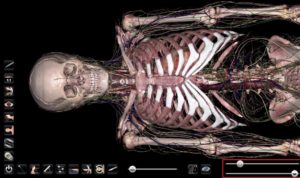
A high-tech medical device likened to a human-sized, turbocharged iPad represents a revolutionary new era in Flinders University’s medical training for regional and rural areas of South Australia and the Northern Territory.
Described as the most technologically advanced system for anatomy education in the world, Flinders has unveiled four Anatomage tables, enabling autopsies without a cadaver.
Vice-Chancellor Professor Colin Stirling says the Anatomage table uses high-resolution touch-screen technology to replicate in the finest detail the human body in all its glory, with a magnitude of possible settings available such as radiological images and multiple pathologies.
“It’s the kind of experience and opportunity that pathologists have dreamed of for centuries— the ability to peel back the layers of the human body one by one until you have examined every part, then put each layer back until it is perfectly in one piece again,” Professor Stirling says.
“In an Australian first, Flinders’ purchase of four Anatomage tables will allow staff and students in Darwin, Mount Gambier and Renmark to link in to expertise in Adelaide in real time, with all participants seeing the identical procedure. It’s a game changer for medical training outside of capital cities,” he says.
Flinders University Rural Clinical School (Renmark) Associate Dean Professor Jennene Greenhill believes the device will transform the Riverland’s medical offerings.
“It cuts down on the need for a seven-hour round trip for students, who until now have had to travel to Adelaide for practical experience and for social connection around learning,” Professor Greenhill says.
“This technology means they have access to the best minds and expertise without leaving Renmark.
“I’m especially excited about the opportunity this opens up for Indigenous students, who are early adopters of technology.
“This technology overcomes concerns about anonymity and respect for the dead, revolutionising clinical learning.”
Professor John Wakerman, Associate Dean, Flinders Northern Territory, says the tables reflect the enterprising spirit of the NT Medical Program, a bold venture characterised by innovation.
“There’s nothing else like it in South Australia or the Northern Territory,” Professor Wakerman says.
“For students in the Northern Territory in particular, this will mean unprecedented access to a level of anatomy training far beyond anything they have experienced before, which can only be good news for the communities they will eventually serve.”
As the future of medical training in the rural continues to evolve, the curriculum is being customised to the local context as we tap into the deep clinical and public health expertise in the Territory, he says.
“With our local partners, we are developing seamless training pathways for graduates into specialist training and there is a stronger focus on multidisciplinary training to produce the team-ready professionals that we need.
“We are also in discussion with our neighbours in the Asian region about sharing our expertise, bringing an increasingly international dimension to our work.
“The bold NT Medical Program experiment has paid off handsomely, and we are producing graduates not just trained to work in some of the most challenging regions of remote Australia but capable of working in cities and rural areas anywhere in the world,” Professor Wakerman says.

